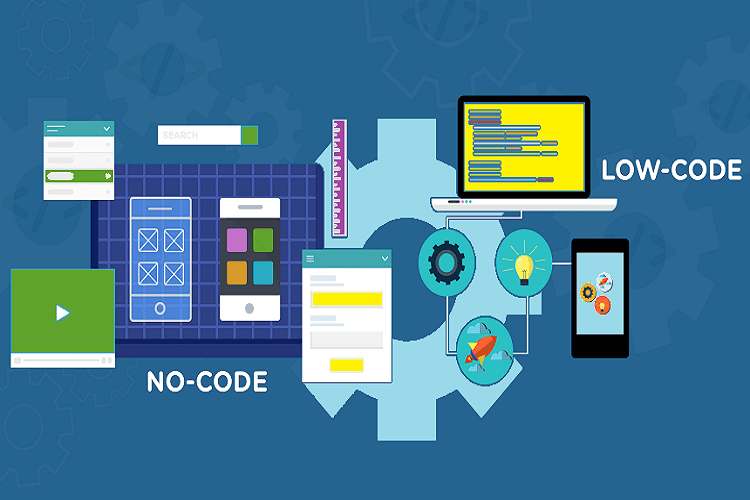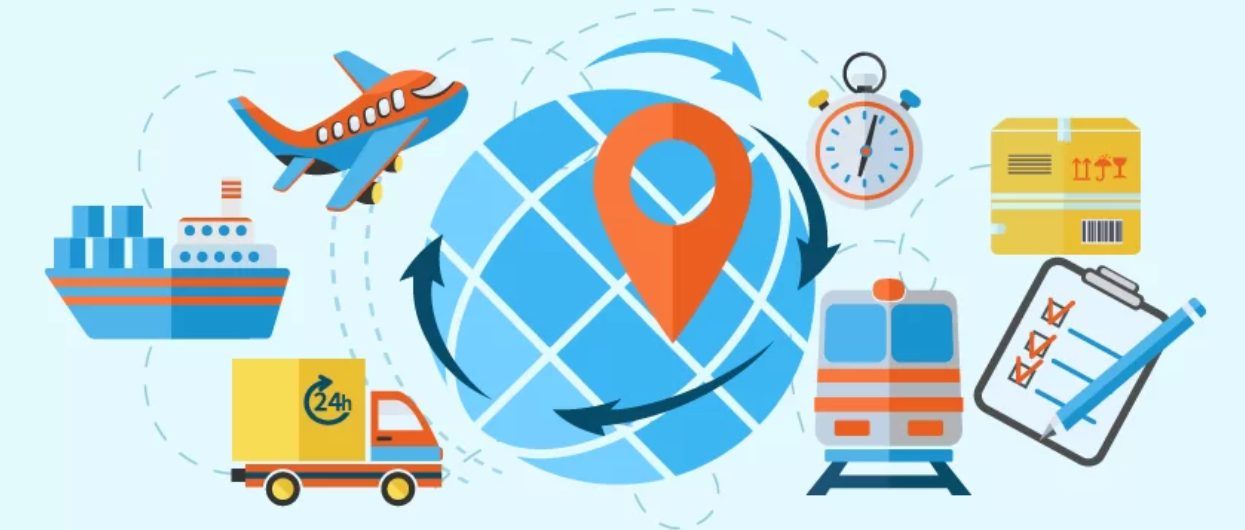The economy, businesses, and daily life are all taking a hit due to issues with the global supply chain. Many facets of supply chain operations, from storage and inventory management to orders and shipping, can be simplified with the use of no-code and low-code app development platforms. Let’s discover further details about no-code and low-code solutions in logistics and supply chain as well as their benefits and drawbacks via this article.
What Are NoCode And LowCode?
Systems like LowCode and NoCode app development help bridge the gap between programmers and businesses.
NoCode platforms and builders don't call for any prior knowledge of computer programming because they display the code graphically. You can simply drag and drop features, screens, and controls without having to write any code. It's a perfect fit.
LowCode, however, requires some experience. Building and tuning the app is still very simple, but it needs a basic understanding of programming logic to make the most of it. Nevertheless, LowCode platforms have the capacity to streamline the app development process and enhance overall efficiency, especially for seasoned developers.
Numerous possibilities for improvement in supply chain efficiency have been available since the introduction of no-code and low-code technology. Possibilities include better communication and coordination between stakeholders and other business partners across the entire vertical supply chain.

Current Problems Of Traditional Supply Chain And Logistics
Since problems in the supply chain can arise at any point and are interconnected, finding solutions can be challenging.
For instance, manufacturers are unable to get essentially raw inputs or deliver final products due to supply chain disruptions. As a result, stores are unable to stock their shelves. Accordingly, customers either have to wait a long time to receive the goods they need or are unable to get them at all. And inflation has been on the rise for the first time in a long time.
Particularly, the following difficulties can interplay in ways that can test the adaptability of even the most nimble of businesses.
Timing
In the industrial industry, timing is extremely crucial. Businesses can't keep running without having access to the correct products from the right factory at the right time. Any disruption to a manufacturer's strictly planned scheduling, such as problems with suppliers, shipment delays, or the addition or removal of shifts for workers, can cause significant challenges farther down the production line.
Cost
Unforeseen expenses arise when the supply of a necessary commodity suddenly drops or increases in price, as can happen as a result of inflation, natural disasters, geopolitical concerns, or other factors beyond the control of the supplier. The manufacturer, who is usually restricted to set budgets, will have to fork up extra cash to replace the lost material.
However, the implications of supply problems extend beyond monetary considerations; efficiency costs must also be factored in. As each department scrambles to make up for the missing component, the previously seamless communication between engineering, manufacturing, and procurement is disrupted.
Safety of Supply
Supply chain decisions aren't always based on cost, though. Manufacturers are typically fine with spending a little extra on a component in order to get a competitive edge. For instance, Apple famously used this strategy when creating the iPad. The company purchased the vast majority of the industry's touch screen glass in order to stall the entrance of possible competitors.
And of course, if a manufacturer can't produce anything due to a scarcity of parts, no amount of cost savings will assist their bottom line. Given this reality, procurement professionals whose focus used to be on continuously refining just-in-time inventory techniques are shifting their attention to securing their supply stock at whatever cost.
Laws
Regulations, such as trade embargoes and environmental standards, are always changing, making it more difficult for manufacturers to source the materials they need. For instance, in 2023, the German government aims to pass a new Supply Chain Act. This law will mandate companies to verify that their abroad suppliers are treating their employees with dignity and respect.
As countries strive to defend and project their national values in the global market, strict supply chain laws like this one will continue to proliferate. In order to comply with these rules, manufacturers must constantly devise new strategies.
Benefits Of No-Code And Low-Code For Supply Chain And Logistics
Quickening of the pace of digitalization
Rapid progress encourages new ideas to emerge. Because no-code and low-code platforms eliminate the need for extensive logistics software development and testing, they make it simpler for supply chain teams to implement new technologies and make adjustments. They can instead make changes to the workflow as needed, which lessens their reliance on other divisions.
Meanwhile, IT staff have more time to incorporate advanced technologies like AI and RPA into operational procedures.
Increased efficiency and collaboration
Simple automation activities, such as digitizing paper-based material like manuals, guides, instructions, and audit reports, can be made much easier with the help of low-code platforms. They can also be used to create low-code supply chain apps that solve specific issues, such as bridging the gap between data from several warehouse systems.
Supply chains can be better optimized and underutilized potential can be reduced with the help of automation tools and regular software updates. Users are freed from mundane managerial responsibilities and allowed to concentrate on strategic projects and activities.
Having open lines of communication between teams and vendors is made easier when information about orders, payments, shipping, and delays is shared in real time.
Cost-efficiency
The ability to create easy solutions for specific problems without having to invest in the services of highly skilled programmers is a clear benefit of low-code platforms. You can save time and energy searching for people, but you will still need specialists with a specific level of coding expertise to create a full-fledged supply chain application.
Low-code app development is a lot easier and quicker than traditional full-cycle development. It offers businesses a wide range of options for creating and releasing applications across many platforms. As a result, they get their apps sooner while only paying a fraction of the normal cost to create and maintain them.
>> You may be interested in: How Much Does It Cost To Design an App?
Faster time-to-market
Using no-code technology, companies may streamline their supply chain and logistics, resulting in faster product launches. Businesses that need fast turnaround times or need to keep up with industry trends would profit substantially from automation of many jobs in the process because it shortens the time between the warehouse and the customer.
Businesses can become more competitive in an increasingly cutthroat market by using no-code solutions to quickly develop applications that streamline the company's whole delivery chain.
Enhanced customers’ experience
In the logistics and supply chain sector, no-code technology can greatly enhance the client experience. By automating many of the routine and time-consuming tasks, businesses may speed up product delivery, making for happier consumers who are more inclined to make repeat purchases and spread the word about the company.
Additionally, no-code platforms offer real-time updates, allowing customers to precisely track their shipments and know when to expect their items. This improves communication between business owners and customers, which in turn fosters a higher level of confidence.
Empowering non-technical team members
A supply chain analyst may need to access data from internal programs, but may lack the coding skills to do so. Using a no-code platform, they may construct a dashboard to monitor KPIs without having to learn to code. Without involving IT, the analyst can find problem areas and make data-driven decisions.
By removing the need for coding expertise, no-code platforms make it possible for non-technical team members to actively contribute to supply chain improvement.
Foster long-term viability
Low-code's potential to solve a new challenge in supply chain management, sustainability, is attracting more and more attention from manufacturers. To reduce their negative effects on the environment, businesses are developing a global circular economy that eliminates waste while increasing productivity and competitiveness.
Keeping tabs on environmental implications is made much simpler with low-code's comprehensive supply chain overview. Manufacturers can protect themselves from sustainability breaches that might destroy their performance and reputation thanks to the insight into supply chain operations made possible by low-code.
Give insights into both predictability and agility
The inability to see the big picture is the primary cause of friction in supply chain optimization. The manufacturing process involves a large number of parties, who work together on a wide range of tasks, including the development of a supplier network, demand forecasting, planning, and procurement, transportation, and delivery. As a result, it is difficult to get useful information.
Low-code platforms streamline data collection, allowing for quicker, more informed decisions. It also helps producers weigh the pros and downsides of their various options. Low-code platforms also assist bring up-to-date older systems, streamline operations, and forge stronger bonds between parties.
They allow stakeholders and business domain experts to take charge of curating apps that can provide insights on data, actionable tasks, and timely collaboration mechanics, hence increasing the effectiveness of supply chain systems.

Challenges Of No-Code And Low-Code For Supply Chain And Logistics
While an increasing number of businesses are using low-code technology into their supply chain operations, it is important to note that this approach cannot entirely substitute the expertise and knowledge of skilled developers. The following are the prevailing difficulties encountered while integrating low-code applications with business operations.
Confined Potentials
As the company expands, low-code solutions will no longer be enough for all projects. When picking between traditional app development and low-code app development, this is a major factor to consider. Open technologies, which include Open Standards, Open Source, and Open Software, are usually used by popular low-code platforms to reduce this danger.
The capabilities of low-code platforms can be expanded by adding custom UI components or code (JourneyApp, for instance, lets developers use React for this purpose).
Low-Code Experts Are In Short Supply
While low-code platforms are accessible to a wider audience, the development of supply chain applications still requires some technical know-how. For instance, low-code platforms require knowledge of a visual language like Business Process Modeling Notation (BPMN).
The learning curve for your team, however, will be greatly diminished because of the intuitive interface, plentiful hints and prebuilt patterns, and the drag and drop feature. Even more sophisticated solutions that allow developers to create their own code provide a library of APIs, utility functions, and auto-complete to speed up and simplify the coding process.
Privacy and Data Protection
Since the data is simple to understand and modify for your company, unauthorized third parties can do the same if they gain access. Therefore, it is crucial to restrict access to the backend platforms used to develop and customize your apps to only a select group of trustworthy employees.
>> You may consider: Web Application Security Guide for Businesses
Maintaining a Healthy Ratio of Personalization to Consistency
With so many different configuration possibilities, it's important to keep in mind the need for consistent procedure. Don't go overboard in your quest to give the app a fresh feel by changing every little thing. The finest outcomes will come from taking your time to standardize the development while still keeping it tailored to your needs.
Supplier Monopoly
The ability to export application code to local databases or gain access to source code may be disabled or restricted on some platforms. In other situations, the code that is exported isn't in a usable state. Consequently, the company's reliance on the services, customization, and technology stack provided by the vendor grows, and it becomes very impossible to migrate the application to another platform.
Working with reputable vendors who have experience creating low-code applications can help solve this problem. By doing so, you can guarantee that everyone has access to the source code and can export their data.
Different Types Of No-Code And Low-Code For Supply Chain And Logistics
Controlling Stock and Resources
Every supply chain relies on a detailed record as it is a critical component to its smooth operation. Serious fines and delays may be imposed for even the tiniest of errors or shortcomings.
In order to design application strategies, it is necessary to determine and organize supply of raw materials, replacement measures, etc. No-code software development makes this process simple. Better management and oversight of your stock is yours to enjoy as more of the process is automated.
By streamlining the process of updating your projects from beginning to end, you can save a lot of money and time. You can also set up alerts and notifications to make sure a shortage never happens.
Supply-Chain and Logistics Locating Administration
Everything from products to vendors to negotiating conversations must be optimized, making procurement a critical part of supply chain management. Automation through acquisition statistics can enhance these features, leading to faster processing and better outcomes.
By reorganizing your procurement processes to include consultations, approvals, and getting commands, you can use no-code to ensure that you get the right products at the right time and price. You can now confidently outpace the competition thanks to automation's elimination of procurement concerns.
Contentment And Warehouse
Every supply chain and logistics company needs a system for organizing their warehouses. Warehouse operations like picking, transactions, shipping, etc., require a system that can monitor the activity and storage of goods.
The implementation of no-code solutions in warehousing and fulfillment operations offers a means to exert control over the industrialization process, facilitating the acceleration of order processing. By integrating sales, purchases, and stock data, and implementing automation in operations, businesses may ensure the provision of high-quality service to their consumers.
Once the method has been entirely automated, the potential for errors is eliminated, as any physical imperfections are likewise rectified through the use of a no-code approach.
Transportation Company
Every supply chain and logistics firm relies heavily on its delivery system since the speed with which goods may be turned over directly affects income. The more products you sell, the more money you'll make, and the more successful your company will be.
Having a reliable delivery system in place is crucial to a company's ability to remain cost-effective and respond to the cumulative pressures of its industry. With no-code, you may set up a delivery team without investing heavily in software engineers and programmers.
No scripting knowledge is required to automate your shipping processes so that they may be seamlessly integrated with other supply chain and logistics activities like inventory management, warehouse layout, and order management. Customers will be happier, logistical costs can be managed, and turnaround times for orders can be cut down significantly across the board in the supply chain.
Repairs And Returns In The Logistics And Supply Chain
Supply chain and logistics firms face particularly large challenges from returns and repairs. A combined inventory and asset management system that allows for the tracking of consecutive components and the generation of functioning transactions can help with the allocation of associated challenges. Accurate inventory appraisal is another area where automation may help.
Reduce return costs and turnaround time for repairs by doing away with laborious, error-prone manual processes with the help of no-code features. By automating the entire process, from returns to repairs, you can cut costs and increase customer satisfaction.
Important Considerations When Choosing A No-Code Or Low-Code Supply Chain Platform
The sheer number of factors that must be taken into account and questions that must be answered when deciding on a platform or vendor might be daunting. Considerations for locating suitable no-code supply chain optimization platforms are provided below.
Scalability
You will have different supply chain requirements as your company expands. When choosing a platform, it's important to make sure it can handle growth in data, users, and complexity as your business expands.
Key Considerations:
- Think about how the platform will respond to a surge in activity, both in terms of users and software.
- Check to see if the platform has price plans that can scale with your company.
- Find out if your data storage, processing, and/or integration options have any restrictions.
Easy Use And Adoption
Your team's proficiency with the no-code platform is crucial if you want to reap its full benefits. If you want widespread acceptance within your company, you should select a platform with a simple UI and a minimal learning curve.
Key Considerations:
- Is it simple to learn how to utilize the platform?
- Find out if the provider provides training resources and initial setup assistance for your staff.
- Can your current procedures and workflows be seamlessly incorporated into the platform?
- Check into whether or not the platform provides demos to give your staff a taste of what it has to offer.
Adaptability And Individualization
Because every supply chain is different, your no-code platform should be flexible enough to meet your needs. Find a system that allows for extensive personalization so that you can build specialized software that meets the needs of your business.
Key Considerations:
- Is there a wide selection of pre-made templates and parts available on the platform?
- Can these pre-built forms and parts be simply tailored to your needs?
- Is there a limit to how much the platform's UI, reporting, and analytics features may be tailored to my specific needs?
Compatibility With Current Infrastructure
The platform should be compatible with your current supply chain systems to guarantee smooth data flow and interoperability. Your existing supply chain systems includes:
- Enterprise Resource Planning (ERP);
- Logistics Management Software (LMS);
- Transport Management Software (TMS).
Key Considerations:
- Does the platform have pre existing connections to common SCM tools?
- Are APIs and other integration technologies readily available for creating bespoke integrations?
- Can data be synchronized in real time between different systems on this platform?
- Is it possible to compose on this platform?
Safety and Regulations
It's vital to keep your supply chain data safe. To ensure the safety of your data and to stay in line with regulations, use a no-code platform that has strong security features and compliance certifications in place.
Key Considerations:
- Do you conduct audits, tests, and updates on a regular basis to ensure continued security?
- Is it possible to encrypt sensitive information and authenticate users in a safe manner on this platform?
>> Read more: Top 10+ Best AI Development Tools for Software Developers
Conclusion
As businesses seek to eliminate laborious processes and increase their level of awareness, the need for no-code and low-code solutions for supply chain and logistics has increased.
When it comes to supply chain and logistics, low-code and no-code solutions are ideal for businesses who are struggling with a dearth of skilled inventors and shrinking IT budgets. These platforms make it simple for even non-technical employees to build applications and hone their creative skills.
>>> Follow and Contact Relia Software for more information!
- development

